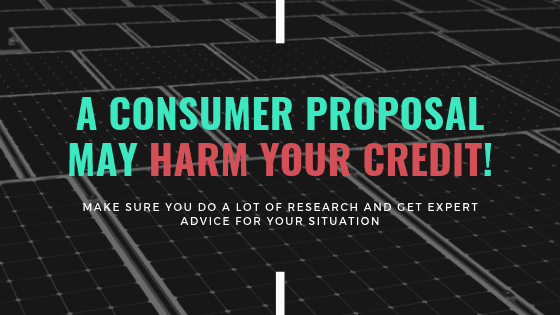Consumer Proposal in Canada: What it is and How it Works?
Canadians who are unable to pay overwhelming debt have access to a consumer proposal among other solutions. The consumer proposal in Canada involves negotiation with creditors to pay a portion of their debt over time. It is managed by a Trustee authorized by the Canadian government to administrate insolvency proceedings. Once completed, the arrangement ends with forgiveness of the remaining balances.
Because there are definite pros and cons to consider, individuals should soak up accurate information before jumping into consumer proposal process or any other debt relief solution. Like bankruptcy, it is a legally binding process with serious financial consequences if the terms are not followed.

Topics
#1: Consumer Proposal Process
#2: What a Proposal Is Not
#3: Types of Debt Allowed
#4: Consumer Proposal vs Bankruptcy
#5: A Consumer Proposal Can Damage Credit
Consumer Proposal Process in Canada
Insolvent Canadians who owe less than $250,000 (not including mortgage) are eligible to file. The offer for the borrower to make partial payment on unsecured debt owed to creditors is made through a Licensed Insolvency Trustee (LIT). If accepted, monthly payments continue over a period of time. Once completed, lenders agree to bring the balances to zero, eliminating the debt.
The consumer proposal process starts with an initial debt assessment by the LIT. The trustee looks at income, budget, and assets to get an idea of what a bankruptcy payment would be for the borrowers. With this figure as a starting point, the trustee will formulate an offer to the creditors that is slightly more than a bankruptcy payment. Why? Because at the end of the proposal the lender will forfeit a portion of the debt, unlike a bankruptcy.
The assessment includes making sure that the consumer can afford the monthly payment offered to creditors. Basically, the next steps in the process are:
1. Signing and filing. The documents are filed electronically (and also mailed), which puts protection from creditors in place immediately. Filing is followed by a waiting period during which each creditor in the proposal can accept, reject or request a creditors meeting.
2. A consumer proposal is approved automatically unless a meeting of creditors is requested by more than 25% of creditors. Once approved, the borrower must make payments on time each month. The proposal can be paid off early with extra payments.
3. Proposal completion. Borrowers receive a full performance certificate at the end of the payment period, which is usually 3 to 5 years. At that time the debts are removed and the completion is reported to credit bureaus. It is removed from the credit report after a 3-year waiting period.
Completion also includes counseling sessions. Borrowers receive guidance on rebuilding credit and effective money management practices. A minimum of two mandatory financial counseling sessions must be finished before a proposal is considered complete.
What a Consumer Proposal is Not
There are complex issues to be addressed in this process. However, Licensed Insolvency Trustees have decades of experience to ensure an acceptable proposal and to navigate obstacles which may arise. Consumers are less stressed if they not only know what a consumer process involves, but what it does not entail.
A consumer proposal is not:
- A relief option that borrowers can file by themselves. LIT’s are licensed by the Office of the Superintendent of Bankruptcy Canada. They are regulated by the Federal government and they alone are authorized to file.
- An optional monthly bill. Missed proposal payments can mean cancellation of the agreement-with debt restored and collection efforts following close behind.
- Available in the United States.
- A means to negotiate payment of secured credit obligations. Borrowers must continue to make payments on home mortgages and auto loans during the proposal.
As long as secured credit payments are kept current, a consumer proposal will not affect assets like a house or vehicle, as these items are protected during the proposal. Some borrowers opt to surrender secured assets instead of making payments. However, the LIT works to formulate a budget that consolidates unsecured debt with an affordable payment. Thus, most borrowers find it easier to maintain monthly house and car payments.
Types of Debt Allowed
Unsecured credit is debt that is not protected from nonpayment by an asset. A secured asset may be a house, automobile, or other property upon which a lien is placed in case the borrower defaults. An example would be a home equity loan or a car title loan. A consumer proposal is an agreement to eliminate unsecured debt only. This includes credit such as:
Canadian debt relief and consolidation is unique from the parallel system in the United States. Consumer proposals may also include income tax and some types of student loans. With rare exceptions, these debts cannot be discharged or eliminated in U.S. bankruptcy courts.
Consumer Proposal vs Bankruptcy
It is most likely difficult for the average consumer to choose between a consumer proposal and Canadian bankruptcy. To the frazzled debtor, it appears to be a choice of two equally confusing selections that are pretty much the same. The Licensed Insolvency Trustee will explain a consumer proposal in Canada can be an alternative to a personal bankruptcy, though there are distinct differences like:
1. Monthly income reporting is not required
2. Secured assets are not surrendered
3. Bankruptcy costs are primarily income based; consumer proposals have several fixed costs for certain steps in the process.
4. A first-time bankruptcy in Canada usually lasts from 9 to 21 months. Typically, consumer proposals are complete in 5 years or less.
5. A Canadian bankruptcy subsequent to the first one stays on the credit report 14 years (first bankruptcy remains 7-9 years depending on province). All consumer proposals are removed from the credit file after 3 years.
Consumers have other debt payment options such as loan settlements. But finding a resource to get a grip on finances that have gotten out of control is a weighty undertaking, since each type has serious financial implications if things don’t go as planned. The LIT is well qualified to assist individuals in selecting a loan repayment program that is a suitable fit.
A Consumer Proposal Can Damage Credit
The pressure of dumping heavy debt at affordable payments is a definite plus in favour of consumer proposals. There are negative aspects to this means of repayment as well. Its effect on the credit score is number one.
A debt that is part of a bankruptcy is reported as an R9, which is the worse rating. A consumer proposal entry is rated R7. Slightly better, but there’s more involved. The Canadian credit report of an individual with a consumer proposal displays an actual warning (as in, “Danger!”) to creditors that the person is insolvent and has court ordered protection. Although both debt relief solutions are similar, it is the manner of their reporting that can be really harmful to the consumer that is trying to restore his credit file.

Like bankruptcy, a consumer proposal has long term consequences, starting with a publicly searchable financial record. Potentially, employers often reject applicants who have a one on their credit file. Insurance rates and bonds can also be impacted by an insolvency. In the future people with a consumer proposal on their record might only be eligible for bad credit loans.
Should a consumer forgo assistance to overcome debt to avoid these possibilities? Is trying to pay back overdue personal loans and credit cards directly to the lender the best course of action? Only the individual can make the decision that will end with their personal optimal outcome. For certain, consumers should never make a snap decision when it comes to finances. In fact, making no decision at all is prudent without performing extensive research and getting professional advice first.
Credit Repair after a Consumer Proposal
Find Credit Repair Solutions – Smarter Loans Can Help
You’re probably going to need to some research on financial companies before agreeing to any of their services.
Here are our top 3 things to ASK before agreeing to work with a financial service provider.
1. Are they licensed?
2. Are they transparent about their fees & rates?
3. Can you get in touch with them over phone or email?
Pro tip: Remember to avoid any loan companies that ask you for money upfront. This practice is not legitimate and usually ends up as a scam. Licensed financial companies won’t do that. Use an unbiased financial directory like Smarter Loans to find the right financial solution for your situation. Discover, research and compare various providers of financial products for any purpose, all over Canada.

Canada’s Top Credit Building Solution Providers
[lenders canadian_state=”on” include=”6567″]







